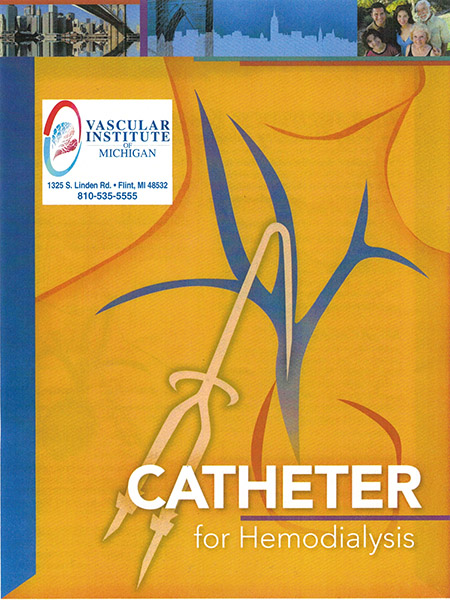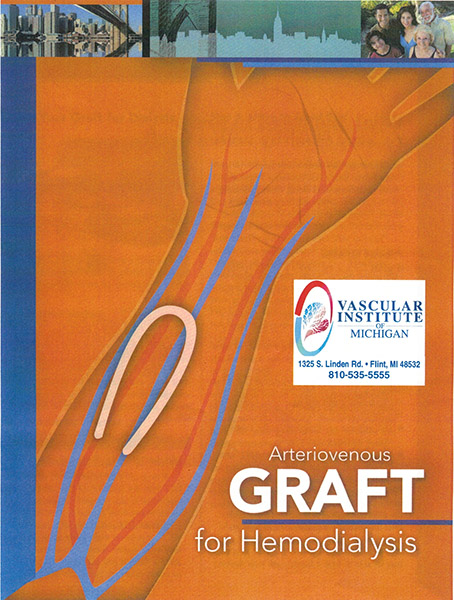Graft
What You Need to Know to Stay Healthy With a Graft
One treatment choice for kidney failure is hemodialysis (HD). HD removes wastes and excess is a vascular access - a way to reach your blood. There are three types of access: graft, fistulas and catheter. This page is about grafts.
About Grafts
A Graft is made by using a piece of synthetic vein to connect an artery and vein. Your artery has the strong blood flow needed for HD. Veins are close to your skin's surface, so a graft is placed in your arm. You may have a graft in your leg if you have no more sites in your arms.
Grafts are the second best kinds of access. A fistula - a direct link between an artery and a vein - is best if you have one. Compared to a fistula, a graft is more likely to:
- Get infected or clotted, since the synthetic vein is foreign to your body.
- Wear out, because the synthetic vein does not self heal after each use.
For these reasons, most grafts need "tune-ups" in the hospital. How often? It depends on the graft and how well it is cared for. Guide-lines for doctors say at least 70% of new grafts should last 1 year and 60% should last 2 years, and 50% should last for 3 years. (If a graft fails, you may be able to have a fistula - ask your doctor.)
After surgery, a graft can be used for HD in about 2 weeks, or after the swelling goes down. The doctor or nurse will decide when it is ready
Kidney disease is mostly hidden - people don't know you have it unless you tell them. But a graft (or the scar on your arm over it) may show, which you will need to get used to. It is normal to be sad about changes to your body, and okay to want to talk to someone about your feelings. Your dialysis Social Worker and other patients may be helpful to talk to.
What is "Steal Syndrome"
A surgeon must balance your need for HD with the function of your arm. Steal syndrome means the graft “steals" too much blood from your arm.This leaves your hand cold and numb. If it happens, tell your surgeon right away; your graft may need repair. Wear a glove during HD, ask if a heating pad would be safe for you, or move your arm around to feel better.
Using Your Graft for Dialysis
Step 1: Hand washing
The first step in using a graft is for the staff person to wash his or her hands. The Occupational Safety and Health Administration (OSHA) requires staff to wash their hands and wear gloves to protect them and you. Your center will teach you how to wash your access arm before HD.
Step 2: Look for infection
At each HD treatment, your nurse or technician will look for signs of infection or damage to your graft. These include:
- Redness, warmth, or swelling
- Tenderness
- Pus or sores
If you have a fever or feel run—down, tell your care team.
Step 3: Listen for blood flow
The nurse or technician will listen to the blood flow in your graft with a stethoscope.
Step 4: Clean the access with germ-killer
The nurse or tech will clean your arm with a gauze pad and a germ—killing solution before using your graft for HD.
Step 5: Place the needles
Two needles are used for HD. An “arterial” needle takes your blood to the dialyzer. A “venous” needle brings your blood back to your body. The nurse or technician will tie a tourniquet (rubber band) around your arm so your blood vessels stand up. Then he or she—or you—will guide one needle at a time through the skin into your graft, tape it down, and connect it to the HD tubing. During HD, the needles should not hurt. If they do, tell your care team.
Step 6: Remove the Needles
After a treatment, the nurse or technician—or you—will untape and remove the needles. As soon as the needles are all the way out, you will need to put on surgical gloves and put pressure on the needle sites for about 10 minutes to stop the bleeding. Never let anyone press on your graft while the needles are being re- moved: this can damage your graft. The staff will teach you how to use the right amount of pressure. Not holding your sites long enough can cause hematomas (bleeding under the skin) or bleeding after you leave the center.
Body Image and Grafts
Whatever makes you most comfortable is okay - whether it's proudly showing off your access or covering it up.
"My upper left arm has a graft in it that I never even used...it's a mess. My lower left arm has my working graft [that] I have had several revisions on, and there are a couple of areas where, after 6 years of use, it bulges. I look like Popeye. I could hide it all, I suppose, but when the weather gets hot, I want a short sleeve shirt. And I still swim when I get the chance. I decided not to let my life be dictated by what others think. I am enjoying this life, courtesy of the Grace of God and this graft. I have used the opportunities presented to educate others about dialysis and organ donation. So instead of a negative...it turns into a big positive, you see. Just like my war wounds from having three kids - stretch marks and C-section incision. I wouldn't trade them for anything."
"I have a skin colored (loose) elastic sleeve I wear over my forearm graft when I wear short sleeves. It goes from my wrist to my elbow. Although it is noticeable, it is nicer looking than my bumpy arm. But I mostly wear it to protect my bumps from getting nicked. I got it at a medical supply store. I think it's for burns. It is very comfortable and gives me some protection"
How to Keep Your Graft Healthy
No HD access is perfect. The first few uses of a new graft may be a challenge. It may be hard for the staff to place the needles, and may even take more than one try. A graft can be infiltrated: a needle goes in one side of the vessel and out the other. Blood leaks into your tissue, causing swelling and bruising. You will need to have a new needle placed, and the bruises can be painful.
Some staff people are very good at putting needles into a new or hard-to-use graft. Most centers will have these staff help you place your needles. Infection, blood clots, and graft tears are other problems that can happen.
Infection
Infection can occur in any kind of access. Bacteria are all over - on skin, in your nose, on surfaces... If the needle pushes them through your skin and into your blood, they can cause blood poisoning, or sepsis. Sepsis can be deadly. Your best defense is to wash your arm or leg with antibacterial soap or alcohol before each HD treatment.
Keep Your Graft Visible at Dialysis
At HD, keep your graft uncovered all the time so the staff can see it. If a needle slips out, or a line comes apart, let the staff will know right away so they can help you. You can wear a blanket - but never cover up your graft.
Bacteria that gets into your body in other ways (like having your teeth cleaned) may reach the graft through your bloodstream and cause infection. Watch for warmth, redness, or swelling over your graft. You might have a fever - or just feel as if you have the flu. If this happens, ask your care team to check your graft for infection
Stenosis: Narrowing of blood vessels
Stenosis slowly shuts off blood flow in your graft, so you don't get enough HD to feel your best. There is often time to fix it before it leads to graft loss. A few things you can do are:
- Feel for the thrill (buzz) in your graft each day. Call the doctor if it changes.
- If you have bleeding that is hard to stop after most HD treatments or that starts up again after you leave the clinic, the pressure in your graft may be high due to stenosis. Call the doctor.
- Don't let anyone draw your blood, start an IV, or take your blood pressure in your graft arm
Fixing Stenosis
Ultrasounds can check the blood flow in your graft. If there is a problem:
- A tiny balloon can be placed in the vessel and inflated (angioplasty).
- A metal stent can be placed into the vessel to hold it open.
- Surgery can be done to revise or replace your graft
Thrombosis: Blood Clots
Clotting cells in the blood (called platelets) stick together. They seal off damaged blood vessels, like a cork seals up a bottle. But platelets will also stick to scar tissue - and each needle forms a small scar. If blood flow through your access is too slow, these small scars can lead to blood clots. A clot can block a graft so that no blood can go through it. The graft will need to be fixed - or replaced.
Unlike stenosis - clotting can happen fast. The major warning sign is a thrill that slows or stops. If you notice this, tell your doctor or nurse right away. Many clots can be treated with drugs, an X-ray guided procedure, or surgery. Other things you can do to prevent clots include:
- Tell your care team right away if you have muscle cramps, or feel faint, dizzy, or sick to your stomach.
- Don't gain too much fluid weight between treatments.
- Know your fluid goal and dry weight. Check that your fluid goal is set correctly on the machine so you don't get too dry.
- Never squeeze your graft: Don't sleep on your graft or carry heavy things across it. Avoid tight watches, bracelets or sleeves.
- Know your dose of anti-clotting drug and ask to be sure you get the right amount.
Graft Tears
Each HD needle leaves a hole - and synthetic grafts can't self heal. If needles are placed in the same small spot over and over, two problems can occur that can be life-threatening:
- A large weak spot in the graft wall can form - and may burst. When blood vessel walls weaken and balloon out, it is called an aneurysm. In a synthetic graft, it is called pseudoaneurysm (false aneurysm)
- Small tears can form in one or more spots along the graft. This is sometimes called "one-site-itis."
When there are tears in the graft - large or small - there is a risk of severe blood loss if the graft bursts. The graft will need to be repaired or replaced.
You can avoid these problems by making sure that needles are always placed at least 1/4 inch away from the last sites used. In this way, no sites are used too much.
What Patients Say About Dialysis Needles
Many people who choose HD are worried about the needles. Medication can be used to numb the needle sites. What is it like to have dialysis needles put in? People who have been through it can tell you:
"I don't use any medications. When I first began I had much the same fear as you. What helped me was to visualize in my mind. I would tell myself the only part that I actually didn't like was the stick. I figured this would only last about one half second for each needle. What I was dreading would only last a total of one second. I figured I could handle the pain that long."
"My experience is that the lidocaine needles sting for a few seconds (sometimes I don't even feel them anymore). On the other hand, the time I have felt the dialysis needles go in, it really did hurt, although not as bad as I would have thought. However the pain lasted for several minutes for me. I would rather have the lidocaine and I'm glad I have the choice."
Conclusion
The goal of good graft care is to keep your lifeline working so you can get good HD. It is your graft and your health at stake. Your chance of keeping your graft healthy is best when you are an active partner with your care team.




